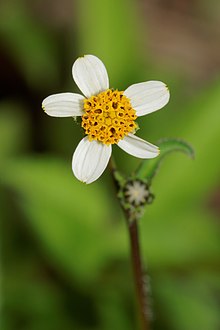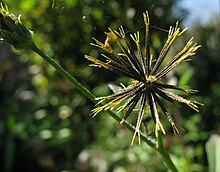Bidens pilosa is an annual species of herbaceous flowering plant in the daisy family Asteraceae. Its many common names include hitch hikers, black-jack, beggarticks, farmer's friends and Spanish needle, but most commonly referred to as cobblers pegs. It is native to the Americas but is widely distributed as an introduced species in other regions including Eurasia, Africa, Australia, South America and the Pacific Islands,[2] and is classified as an invasive species in some regions of the world.[3][4]
| Bidens pilosa | |
|---|---|

| |
| Scientific classification | |
| Kingdom: | Plantae |
| Clade: | Tracheophytes |
| Clade: | Angiosperms |
| Clade: | Eudicots |
| Clade: | Asterids |
| Order: | Asterales |
| Family: | Asteraceae |
| Genus: | Bidens |
| Species: | B. pilosa
|
| Binomial name | |
| Bidens pilosa L. 1753
| |
| Synonyms[1] | |
|
Synonymy
| |



Description
editBidens pilosa is a branched annual forb of gracile habit, growing up to 1.8 meters tall. It grows aggressively on disturbed land and often becomes weedy. The leaves are all oppositely arranged and range from simple to pinnate in form, the upper leaves with three to five dentate, ovate-to-lanceolate leaflets. The petioles are slightly winged.[5]
The plant may flower at any time of the year, but mainly in summer and autumn in temperate regions. The flowers are small heads borne on relatively long peduncles. The heads consist of about four or five broad white ray florets (ligules), surrounding many tubular yellow disc florets without ligules that develop into barbed fruits.[6]
The fruits are slightly curved, stiff, rough black rods, tetragonal in cross section, about 1 cm long, typically with two to three stiff, heavily barbed awns at their distal ends.
The infructescences form stellate spherical burrs about one to two centimeters in diameter. The barbed spines of the achenes get stuck in the feathers, fur, fleeces, clothing, etc. of people or animals that brush against the plant.[7][8] It is an effective means of seed dispersal by zoochory, as the fruits are transported by animals. This mechanism has helped the plant become a noxious weed in temperate and tropical regions.[4][5][9]
Distribution
editThe species is native to tropical America, widely naturalized throughout the warm temperate and tropical regions of the world.[10][11] A weed of gardens, woodlands and waste areas.[12][13][14]
Common names
editIts many English common names include black-jack,[15]: 819 beggarticks, hairy beggarticks, cobbler's pegs, devil's needles, hairy bidens, Spanish needle, farmers friend, Devils Pitchfork, hitch hikers and sticky beaks.[16][17][18]
Uses
editAlthough Bidens pilosa is primarily considered a weed, in many parts of the world it is also a source of food and alternative medicine.[19] The leaves have a resinous flavor, are eaten raw or in stews or dried for storage. In eastern Africa it is used for medicinal purposes for its healing power for wounds.[20]
During the Vietnam War, soldiers[which?] adopted the herb as a vegetable, which led to it being known as the "soldier vegetable".[21] It is susceptible to hand weeding if small enough. Even then it must be bagged, and thick mulches may prevent it from growing.[22][23]
Extracts from Bidens pilosa are used in Southern Africa for malaria.[23]
Chemistry
editAlmost 200 compounds have been isolated from B. pilosa, especially polyacetylenes and flavonoids.[24] The plant contains the chalcone okanin[25] and ethyl caffeate, a hydroxycinnamic acid.[26]
References
edit- ^ The Plant List, Bidens pilosa L.
- ^ Bidens pilosa. Pacific Island Ecosystems at Risk (PIER). USFS.
- ^ "Spanish Needle (Bidens pilosa) - Encyclopedia of Biodiversity (Second Edition)". ScienceDirect. 2013.
- ^ a b "Cobbler's pegs". Weed Identification – Brisbane City Council. Retrieved 2024-03-16.
- ^ a b Flora of North America, Bidens pilosa Linnaeus, Sp. Pl. 2: 832. 1753.
- ^ "Spanish needles: definition of Spanish needles in Oxford dictionary (American English) (US)". www.oxforddictionaries.com. Archived from the original on December 8, 2015. Retrieved 2016-02-11.
- ^ "Plant Discoveries Sherwin Carlquist Island Biology LOSS of DISPERSIBILITY on ISLANDS". www.sherwincarlquist.com. Retrieved 2016-02-11.
- ^ "beggarticks: definition of beggarticks in Oxford dictionary (American English) (US)". www.oxforddictionaries.com. Archived from the original on December 9, 2015. Retrieved 2016-02-11.
- ^ Multimedia, Acura. "*Bidens pilosa — Noosa's Native Plants". noosanativeplants.com.au. Retrieved 2016-02-11.
- ^ "Bidens pilosa (Blackjack)". BioNET EAFRINET Keys and Factsheets. Retrieved 2020-03-25.
- ^ "Factsheet - Bidens pilosa". keyserver.lucidcentral.org. Archived from the original on 2016-03-05. Retrieved 2016-02-11.
- ^ "Bidens pilosa - Cobbler's Pegs - Edible Weeds and Bush Tucker Plant Foods". www.survival.org.au. Retrieved 2016-02-11.
- ^ "Dangars Falls and Salisbury Waters". www.donsmaps.com. Retrieved 2016-02-11.
- ^ "Elizabeth and Rob". elizabeth-nowell.blogspot.com.es. Retrieved 2016-02-11.
- ^ Stace, C. A. (2019). New Flora of the British Isles (Fourth ed.). Middlewood Green, Suffolk, U.K.: C & M Floristics. ISBN 978-1-5272-2630-2.
- ^ BSBI List 2007 (xls). Botanical Society of Britain and Ireland. Archived from the original (xls) on 2015-06-26. Retrieved 2014-10-17.
- ^ "Wilderness Survival, Tracking, and Awareness".
- ^ Atlas of Living Australia, Bidens pilosa L., Cobbler's Peg
- ^ Grubben, G. J. H. & O. A. Denton. (2004) Plant Resources of Tropical Africa 2. Vegetables. PROTA Foundation, Wageningen; Backhuys, Leiden; CTA, Wageningen.
- ^ Pieroni, Andrea (2005). "Gathering food from the wild". In Prance, Ghillean; Nesbitt, Mark (eds.). The Cultural History of Plants. Routledge. p. 31. ISBN 0415927463.
- ^ Tanaka, Yoshitaka; Van Ke, Nguyen (2007). Edible Wild Plants of Vietnam: The Bountiful Garden. Thailand: Orchid Press. p. 38. ISBN 978-9745240896.
- ^ "Sustainable Horse Keeping". goldcoasthorse.com.au. Archived from the original on 2015-12-08. Retrieved 2016-02-11.
- ^ a b Grubben, G. J. H.; Denton, O. A., eds. (2004). Vegetables. Wageningen, Netherlands: Backhuys. p. 115. ISBN 90-5782-147-8. OCLC 57724930.
- ^ Silva, F. L., et al. (2011). Compilation of secondary metabolites from Bidens pilosa. Molecules 16(2), 1070-1102.
- ^ Presence of Compounds in Picao preto (Bidens pilosa). Raintree Nutrition.
- ^ Chiang, Y., et al. (2005). Ethyl caffeate suppresses NF-κB activation and its downstream inflammatory mediators, iNOS, COX-2 and PGE2 in vitro or in mouse skin. Br J Pharmacol. 146(3) 352–63. PMID 16041399
External links
edit- PROTAbase Record display for Bidens pilosa. Plant Resources of Tropical Africa (PROTA). Retrieved on 12 April 2010.